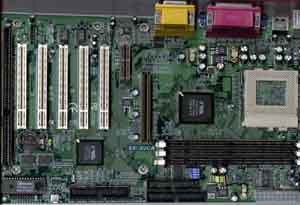VIA Apollo Pro 133/133A Motherboard Roundup - February 2000
by Anand Lal Shimpi on February 28, 2000 1:13 AM EST- Posted in
- Motherboards
EPoX EP-3VCA
|
Motherboard Specifications |
|
| CPU Interface |
FC-PGA Socket-370
|
| Chipset |
VIA Apollo 133A
VIA 694X North Bridge VIA 686B South Bridge |
| L2 Cache |
N/A (on-chip)
|
| Form Factor |
ATX
|
| Bus Speeds |
66
/ 75 / 83
100 / 105 / 110 / 112 / 115 / 120 / 124 133 / 140 / 150 |
| Voltages Supported |
Auto Detect - 1.30v - 3.5v
|
| Memory Slots |
3 168-pin DIMM Slots
|
| Expansion Slots |
0
AMR Slots
1 AGP Slot 5 PCI Slots (3 Full Length) 1 ISA Slots (1 Full Length) |
| AC'97 |
VIA
VT1611A
|
| BIOS |
AWARD BIOS 4.51PG
|
The 3VCA is another Socket-370 solution that we took a look at, and like most of the other Socket-370 solutions (with the exception of the P6VAP-Me), it features absolutely no way of controlling the voltage supplied to the CPU, making overclocking quite difficult on this board.
One of EPoX's trademark features in the past has been their Easy Set Single Jumper (ESSJ) configuration, which is essentially the use of a single jumper to select what FSB setting you would like to run at. The way the settings work on the board is a bit different than the conventional ESSJ on older EPoX boards, in that the jumper actually controls the AGP divider and what FSB settings are available in the BIOS.
Choosing a setting between 66MHz and 83MHz results in an 1/1 AGP to FSB ratio and allows FSB frequencies from 66MHz up to 83MHz to be selected from within the BIOS setup. Picking anything between 100MHz and 124MHz (inclusive) results in a 2/3 AGP ratio and allows those FSB settings to be selected from within the BIOS. And finally selecting the 133MHz, 140MHz or 150MHz settings enable the 1/2 AGP ratio and let you select from those settings in the BIOS. You can consider this setup as being sort of a pseudo-jumperless setup requiring only a small bit of configuration.
The board itself is fairly stable, but unfortunately, that stability comes at the cost of performance as it performs noticeably slower than the top boards in this roundup but not as slow as the ASUS P3V4X.











0 Comments
View All Comments